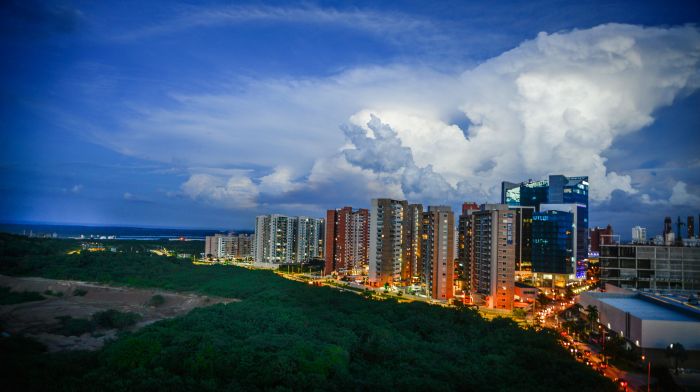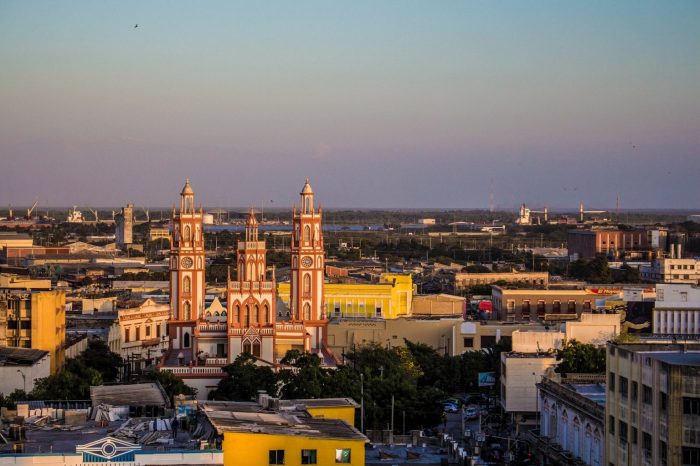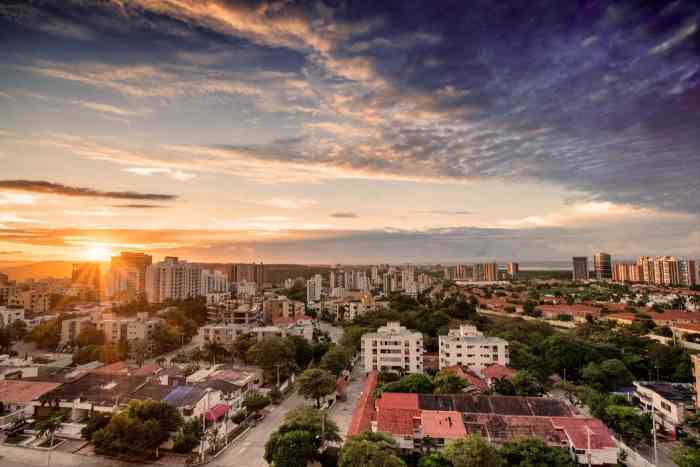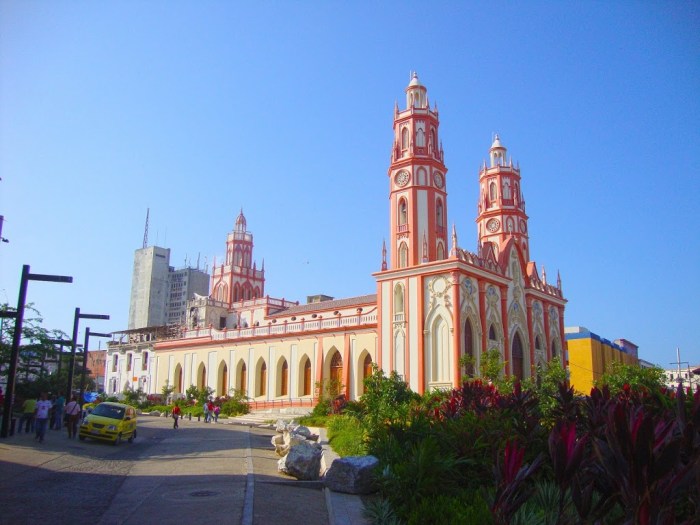Barranquilla, a vibrant metropolis nestled on the Caribbean coast of Colombia, beckons with its captivating blend of history, culture, and economic prowess. From its humble beginnings to its modern-day status as a thriving port city, Barranquilla’s story is a testament to the indomitable spirit of its people.
With its strategic location at the mouth of the Magdalena River, Barranquilla has long been a gateway to the interior of Colombia and a melting pot of cultures. African, indigenous, and European influences have intertwined to create a unique and vibrant cultural identity that permeates every aspect of life in the city.
History of Barranquilla

Barranquilla, a vibrant city in northern Colombia, boasts a rich and captivating history that has shaped its present-day identity. From its humble beginnings as a small indigenous settlement to its transformation into a thriving metropolis, Barranquilla’s journey has been marked by significant events, cultural influences, and economic developments.
Foundation and Early Years
The origins of Barranquilla can be traced back to the 16th century when Spanish conquistadors established a small settlement on the banks of the Magdalena River. The strategic location of the settlement, at the confluence of the Magdalena and the Caribbean Sea, made it a vital hub for trade and transportation.
Barranquilla, a vibrant Colombian city, is a hub for commerce and culture. Among its financial institutions, Bancomer stands out for its reliable banking services. Its presence in Barranquilla reflects the city’s growing economic importance, making it a convenient destination for both locals and visitors to manage their finances.
During the colonial period, Barranquilla remained a relatively small town, overshadowed by larger cities such as Cartagena and Santa Marta. However, the 19th century witnessed a surge in the city’s growth and development.
Independence and Economic Boom
Barranquilla played a significant role in Colombia’s struggle for independence from Spain. In 1813, the city declared its independence and became a stronghold for the rebel forces. After Colombia gained independence in 1819, Barranquilla emerged as a major commercial center, thanks to its strategic location and the opening of the Magdalena River to international trade.
The city’s economy boomed in the late 19th and early 20th centuries, fueled by the export of coffee, tobacco, and other agricultural products. Barranquilla became a magnet for immigrants from around the world, including Europeans, Arabs, and Chinese, who contributed to the city’s cultural diversity.
Modern Barranquilla
In the 20th century, Barranquilla continued to grow and develop, becoming a major industrial and financial center. The city played a significant role in Colombia’s oil and gas industry, and it also became a center for education and culture.
Today, Barranquilla is a thriving metropolis with a population of over 1.2 million people. It is a major economic, cultural, and educational center, and it is known for its vibrant nightlife, music, and dance.
Historical Milestones
The following table provides a timeline of key historical milestones in Barranquilla’s history:
| Date | Event | Significance |
|---|---|---|
| 1533 | Foundation of Barranquilla | Spanish conquistadors establish a small settlement on the banks of the Magdalena River. |
| 1813 | Barranquilla declares independence from Spain | The city becomes a stronghold for the rebel forces during Colombia’s struggle for independence. |
| 1821 | Colombia gains independence | Barranquilla emerges as a major commercial center, thanks to its strategic location and the opening of the Magdalena River to international trade. |
| Late 19th and early 20th centuries | Economic boom | Barranquilla’s economy booms, fueled by the export of coffee, tobacco, and other agricultural products. The city becomes a magnet for immigrants from around the world. |
| 20th century | Growth and development | Barranquilla continues to grow and develop, becoming a major industrial and financial center. The city plays a significant role in Colombia’s oil and gas industry, and it also becomes a center for education and culture. |
Geography and Demographics of Barranquilla

Nestled in the northwestern region of Colombia, Barranquilla boasts a strategic location at the mouth of the Magdalena River and along the Caribbean coast. Its geographical position has played a pivotal role in shaping the city’s development and identity.
Barranquilla experiences a tropical savanna climate characterized by high temperatures and humidity throughout the year. The average temperature hovers around 28 degrees Celsius (82 degrees Fahrenheit), with little seasonal variation. The city receives abundant rainfall, particularly during the wet season from May to November.
Topography
Barranquilla’s topography is predominantly flat, with the city center located on the eastern bank of the Magdalena River. The western part of the city is characterized by low-lying floodplains and wetlands, while the eastern side features rolling hills and mesas. The highest point in the city is Cerro El Santuario, a hill rising to 120 meters (394 feet) above sea level.
Population
Barranquilla is the fourth most populous city in Colombia, with a population of approximately 1.2 million people. The city has experienced steady population growth over the years, primarily due to migration from rural areas and other parts of the country. The population density is relatively high, with around 4,000 people per square kilometer (10,000 per square mile).
- Population Growth: Barranquilla’s population has grown significantly in recent decades, driven by economic opportunities and improved infrastructure. The city’s population is projected to continue growing in the coming years.
- Demographics: The majority of Barranquilla’s population is of mixed race, with significant African, European, and indigenous ancestry. The city is also home to a diverse population of immigrants from other parts of Colombia and neighboring countries.
- Urbanization: Barranquilla is a highly urbanized city, with over 90% of its population living in urban areas. The city’s rapid urbanization has led to the development of sprawling suburbs and informal settlements.
Key Geographical Features and Impact on Development
Barranquilla’s unique geographical features have significantly influenced its development and economic growth:
- Magdalena River: The Magdalena River is a vital waterway that connects Barranquilla to the interior of Colombia. It has played a crucial role in the city’s trade and transportation, making it a major port city.
- Caribbean Coast: Barranquilla’s location on the Caribbean coast has provided access to international trade and tourism. The city’s port is a major hub for imports and exports.
- Cerro El Santuario: Cerro El Santuario is a prominent hill that overlooks the city. It offers panoramic views and serves as a popular tourist destination.
Culture and Arts in Barranquilla

Barranquilla is a cultural melting pot where Caribbean and African traditions converge, creating a vibrant and diverse artistic scene. Music, dance, art, and literature flourish in this city, showcasing the rich cultural heritage of its people.
Music and Dance
Barranquilla is renowned for its infectious music and energetic dance forms. Cumbia, a traditional Colombian folk dance, originated in the city and remains an iconic symbol of its cultural identity. Other popular music genres include vallenato, salsa, and champeta, each with its unique rhythms and dance styles.
Art and Literature
Barranquilla’s art scene is equally vibrant, with numerous galleries and museums showcasing local and international artists. The Museo de Arte Moderno de Barranquilla (MAMB) houses a significant collection of modern and contemporary art, while the Museo del Caribe celebrates the cultural diversity of the region.
Barranquilla, a vibrant city in Colombia, offers a rich blend of culture and modernity. Its bustling streets are a testament to its lively spirit, while its beautiful beaches and parks provide respite from the urban hustle. If you’re seeking a European adventure, consider exploring alicante spain , a charming coastal city with stunning beaches, historic architecture, and a vibrant nightlife.
Upon your return to Barranquilla, you’ll appreciate its unique fusion of Colombian warmth and international flair.
The city has also produced renowned literary figures, including Nobel Prize nominee Gabriel García Márquez and poet Meira Delmar. Barranquilla’s literary heritage is celebrated through events such as the International Poetry Festival and the Hay Festival Cartagena.
Cultural Events and Festivals
Barranquilla is a hub for cultural events and festivals throughout the year. The most famous is the Barranquilla Carnival, a four-day celebration featuring colorful parades, music, and dance performances. Other notable events include:
- Festival Internacional de Teatro de Barranquilla (Barranquilla International Theater Festival)
- Festival Internacional de Cine de Barranquilla (Barranquilla International Film Festival)
- Festival Internacional de Música de Barranquilla (Barranquilla International Music Festival)
- Feria del Libro del Caribe (Caribbean Book Fair)
Economy and Infrastructure of Barranquilla

Barranquilla’s economy is driven by a diverse range of industries, including manufacturing, services, and tourism. The city is home to several major industrial complexes, including the Zona Franca Industrial de Barranquilla (ZIB), which is the largest free trade zone in Colombia.
Barranquilla’s employment rate is relatively high, with over 60% of the population employed. The city’s unemployment rate is lower than the national average, and it has been declining in recent years.
Major Industries
- Manufacturing: Barranquilla is a major manufacturing center, with a strong focus on textiles, chemicals, and food processing.
- Services: The services sector is the largest employer in Barranquilla, with a particular focus on tourism, finance, and healthcare.
- Tourism: Barranquilla is a popular tourist destination, with a vibrant nightlife scene and a number of historical and cultural attractions.
Infrastructure
Barranquilla has a well-developed infrastructure, with a modern transportation system, reliable energy supply, and a strong telecommunications network.
Transportation
Barranquilla is a major transportation hub, with an international airport, a deep-water port, and a network of highways and railways.
Energy
Barranquilla is home to several power plants, which provide the city with a reliable supply of electricity.
Telecommunications
Barranquilla has a strong telecommunications network, with a high level of internet and mobile phone penetration.
Economic Performance Comparison
| City | GDP (USD) | GDP per capita (USD) | Unemployment rate (%) |
|---|---|---|---|
| Barranquilla | $20 billion | $10,000 | 5.5% |
| Bogota | $40 billion | $12,000 | 4.5% |
| Medellin | $30 billion | $11,000 | 5.0% |
| Cali | $25 billion | $10,500 | 6.0% |
Tourism and Attractions in Barranquilla

Barranquilla, Colombia’s vibrant Caribbean city, boasts a rich blend of history, culture, and natural beauty. Whether you’re seeking historical landmarks, vibrant museums, serene parks, or pristine beaches, Barranquilla offers an array of attractions to captivate visitors.
The city’s tourism infrastructure is well-developed, with a range of hotels, restaurants, and transportation options catering to travelers’ needs. The ease of getting around makes it convenient to explore Barranquilla’s many attractions, ensuring a memorable and enriching experience.
Barranquilla’s lively atmosphere and tropical climate make it a vibrant city. However, if you’re seeking a respite from the heat, consider exploring the Bahamas weather. With its crystal-clear waters and gentle breezes, the Bahamas offers a refreshing escape. Upon your return to Barranquilla, you’ll appreciate the city’s energy with a newfound perspective.
Historical Landmarks, Barranquilla
- Castillo de San Antonio de Salgar: A 17th-century fortress overlooking the Magdalena River, offering panoramic city views.
- Plaza de la Paz: The historic main square, featuring the Catedral Metropolitana and other colonial-era buildings.
- Casa del Carnaval: A museum dedicated to the city’s renowned Carnival celebration, showcasing costumes, music, and history.
Museums
- Museo del Caribe: A renowned museum showcasing the cultural and historical heritage of the Caribbean region.
- Museo de Arte Moderno de Barranquilla: Featuring a diverse collection of contemporary and modern art.
- Museo Romántico de Barranquilla: A glimpse into the city’s 19th-century lifestyle, with antique furniture, paintings, and personal belongings.
Parks and Gardens
- Parque Metropolitano de Barranquilla: A sprawling park with walking trails, lakes, and a zoo.
- Jardín Botánico de Barranquilla: A botanical garden with a diverse collection of plants, including an orchid house and medicinal plants.
- Parque de Los Niños: A children’s park with interactive play areas, water features, and a planetarium.
Beaches
- Playa Puerto Velero: A popular beach with clear waters, white sands, and water sports facilities.
- Playa Salgar: A quieter beach known for its calm waters and panoramic views of the city.
- Playa Villa Country: A private beach club offering amenities such as pools, restaurants, and beach volleyball.
Recommended Itineraries
To make the most of your visit to Barranquilla, consider the following itineraries:
- One-day itinerary: Visit the Museo del Caribe, stroll through Plaza de la Paz, and enjoy the vibrant atmosphere of a local market.
- Two-day itinerary: Explore the historical landmarks of Castillo de San Antonio de Salgar and Casa del Carnaval, relax in Parque Metropolitano de Barranquilla, and experience the city’s nightlife.
- Three-day itinerary: Indulge in art at Museo de Arte Moderno de Barranquilla, visit Jardín Botánico de Barranquilla, and soak up the sun at Playa Puerto Velero.
Ultimate Conclusion: Barranquilla

Barranquilla’s allure extends far beyond its historical and cultural significance. As a major economic hub, the city boasts a thriving port, a robust industrial sector, and a growing tourism industry. Its modern infrastructure, coupled with its warm hospitality, makes it an ideal destination for business and leisure travelers alike.
As we bid farewell to Barranquilla, we leave with a profound appreciation for its rich heritage, its vibrant culture, and its boundless potential. This city, once a sleepy port town, has transformed into a dynamic metropolis that continues to captivate and inspire.
FAQ Corner
What is Barranquilla known for?
Barranquilla is renowned for its vibrant Carnival celebration, its rich cultural heritage, and its economic importance as a major port city.
What is the population of Barranquilla?
As of 2023, the population of Barranquilla is estimated to be around 1.2 million.
What is the climate like in Barranquilla?
Barranquilla has a tropical climate with warm temperatures year-round and a rainy season that typically lasts from May to November.